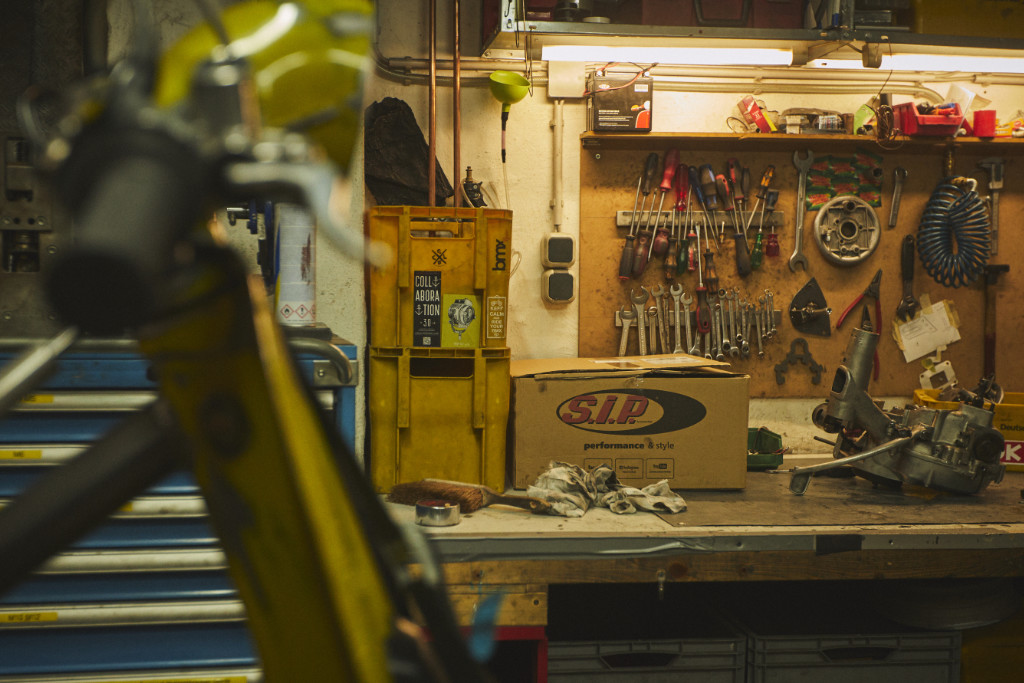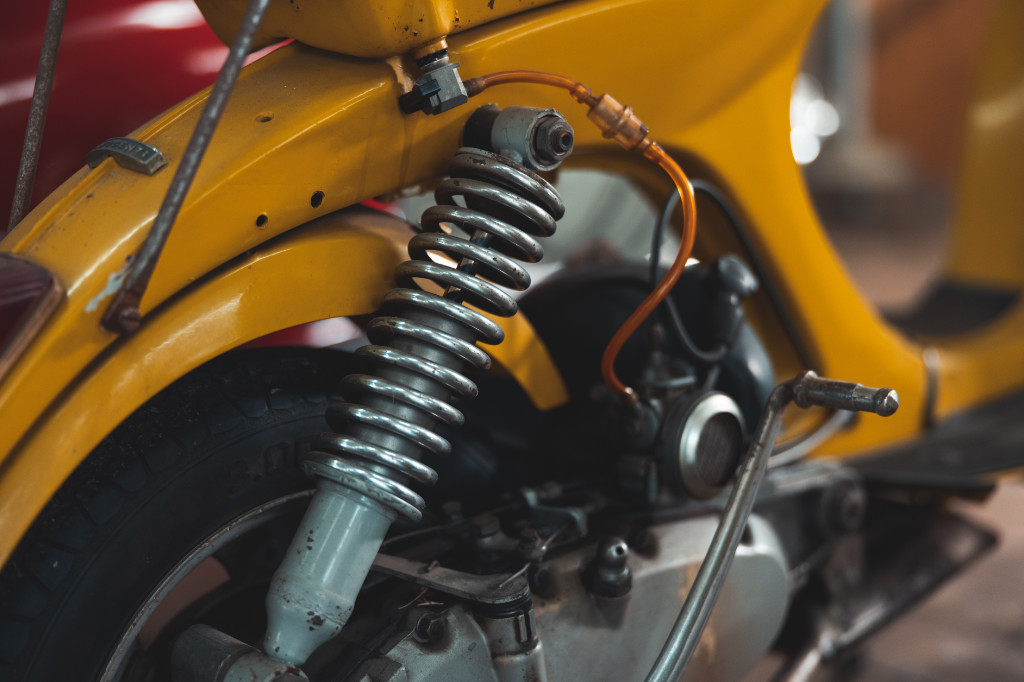A solid chassis shortens the braking distance, improves ride comfort and increases cornering safety. Ride comfort is also determined by the chassis. Many manufacturers are striving to meet the desire of many two-wheeler users for a better chassis. Chassis technology is available in a wide range of options to suit all needs and budgets. Even experienced technicians face the problem of setting all the parameters correctly.
Struts have two main components:
1.) Spring: A spring enables a more flexible wheel suspension. This enables a comfortable ride and even contact of the tires with the ground, even on uneven road surfaces.
2.) Damper: It dampens the deflection movement of the wheel. Without the damper, the force of the spring would result in poor or no road contact when the suspension is released. In addition, this would impair ride comfort.
What are the benefits of the individual setting options?
1.) Spring rate: How much a damper is compressed at a given force is determined by the characteristic curve of the installed spring.
2.) Progressive spring: With progressive compression, the spring force of such a spring increases. Chassis with low spring deflection benefit from this characteristic.
3.) Spring preload: a nut can be used to adjust the length of the spring in the unloaded state.
4.) Rebound damping: rebound damping is usually changed via the adjuster wheel at the end of the inner damper rod. Rebound damping controls how much energy is applied to counteract the outward movement of the spring.
5.) Reservoir: Adds volume to the damping medium from the damper cartridge. Improves the adjustment capabilities of the damper and ensures a consistent damping action with better temperature compensation.
6.) Compression damping: This determines the force with which the damper counteracts the compression movement. The adjustment is often made by a wheel on the reservoir of the damper.
7.) High/Low setting or double compression damping: Here, the counterforce to fast and slow compression movements can be set individually.
The basic structure of the damper
A damper can be constructed in different ways, although most of today’s shock absorbers use the same basic design. A piston is housed in a cylinder and connected to the opposite side of the suspension by means of a piston rod. Oil flows from one side of the cylinder to the other as the piston moves. Since the perforations for the inner and outer spring movements are of different sizes, these movements can be damped to different degrees.
What influence does the spring preload have?
The spring preload does not change the hardness of the suspension, but adjusts the height. This is mainly used to adapt the suspension to changing rider weights, but can also be used to change the geometry, for example on a race track. It’s all about a spring characteristic, i.e. how far a spring compresses when subjected to a certain force. This would mean that a 400 mm long shock absorber is still 320 mm long when loaded. The length available to the spring when unloaded is reduced when the spring preload nut is tightened. This would compress the spring by 40 mm. Since the spring is now compressed less than it was under the force of the 100 kg driver end, it is compressed to the same length as before, i.e. 220 mm.
Important note: The weight of the rider end has compressed the spring to the same length even after it has been adjusted. This means that the spring is still as tight as before the change. The height of the vehicle when loaded with the driver end is the only item that has changed. The ratio of positive to negative spring travel has also changed.
How can the spring preload be adjusted?
To set the preload optimally, the spring travel must first be determined in the unloaded state. Theoretically, the negative spring travel should account for 25-30 percent of the total spring travel. This value is difficult to transfer to the conditions of a conventional shift lever. About 2 cm is a good guide value here.
What does the rebound damping setting do?
Rebound damping compensates for bumps when the wheel rolls over an obstacle. The rebound damping allows you to vary how much force the damper exerts on the spring. If the rebound damping is set too high, a “wind-up” effect can occur. The tire is compressed when it encounters a series of obstacles without being able to deflect between them.
How is the rebound damping optimally adjusted?
The best time to do this depends largely on the length of the suspension travel. A good rule of thumb for a good basic setting is that the chassis should deflect in about one second. If the chassis is decompressing slower, the rebound damping needs to be increased. By “counting along” or saying “one one thousand”, you can judge if the time for rebound is correct.
The expansion tank
Only high-quality suspension systems have an adjustable compression stage. The temperature of the oil is kept constant by an external expansion tank. The diameter of the hole through which the oil flows into the expansion tank can be changed. Another advantage of an expansion tank is that a valve can be placed exactly at the transition from the cartridge to the tank to change the compression stage.
How does the compression level work?
The damper exerts a large force on compression when the valve to the reservoir is closed. When it is open, the compression is only slightly reduced. Compression damping changes the behavior of the spring in a similar way to spring preload, allowing adjustment of characteristics that is not possible with spring preload.
How is the compression damping set correctly?
The correct basic setting of compression damping is more difficult to determine and apply as a rule of thumb than the setting of rebound damping. The correct setting requires both experience and a sure instinct. A dry run is helpful for pre-setting: The rider stands over the scooter and presses his or her full weight onto the corresponding spring damper.
Double compression damping
It’s not easy to adjust a dual compression shock. There are a few things to keep in mind so you understand what is being changed. “Highspeed” and “Lowspeed” are the two compression settings. What is meant is the dual compression damping used to compress the shock, not the speed of the scooter. Even short, violent jolts rarely cause high-speed movement.
In dynamic riding situations, such as long bumps, stopping, or accelerating, low-speed compression damping stabilizes the scooter. If the spring would deflect too much without the pressure damping, it is supported.
How to adjust high and low speed?
With the double compression damping configuration, we have reached stage 2 of the suspension setting. Since the excess pressure cannot be released soon enough, the earlier the high-speed valve opens, the more low-speed compression stages are set. To accomplish this flawlessly takes just a little practice. Five clicks is a value that is occasionally used as a guide.
Note: Set the high and low speed to the same values when you first start. Continue as if you were setting a simple compression damping. After you have found a good value, pay special attention to high speed handling. For example, when braking hard and fast before a corner. The high-speed setting must be increased if the front tire buckles too quickly. Open the high-speed setting if, for example, the rear wheel is damaged by a strong, fast bump, touches a block and pulls up the rear without using the suspension travel.
Summary and conclusion
If you want to set up a chassis correctly, you first have to internalize how it works and understand the effects of the different settings. The only thing that helps is a lot of driving and testing to get a feel for things and compare different settings. It takes time and patience to realize a perfect chassis.
Also, when buying individual components, keep in mind that a stiff chassis is not a good chassis and certainly not a sporty one. The tires must be able to compensate for uneven ground and maintain optimum contact with the road. That is the only thing that is sporty. Therefore, the firmness of a chassis must be compatible with the road surface. A slightly stiffer suspension makes the scooter faster only on particularly smooth roads. Many old scooters equipped with adapted suspension have, after many years of experience, a much harsher setup than would be advantageous even on the smoothest road surface. Anyone who rumbles over cobblestones on their own normal scooter will find that the wheels barely make contact with the road and you see everything double.
In most cases, two settings are enough: Spring preload and rebound damping. For those who are a little more demanding, use the compression damping setting to get good results quickly. Experts with sporty ambitions will appreciate the double compression damping.
Finally, it’s worth looking into the suspension. A solid chassis not only makes driving safer, but also more enjoyable. It’s incredible what can be achieved with the right setting.




